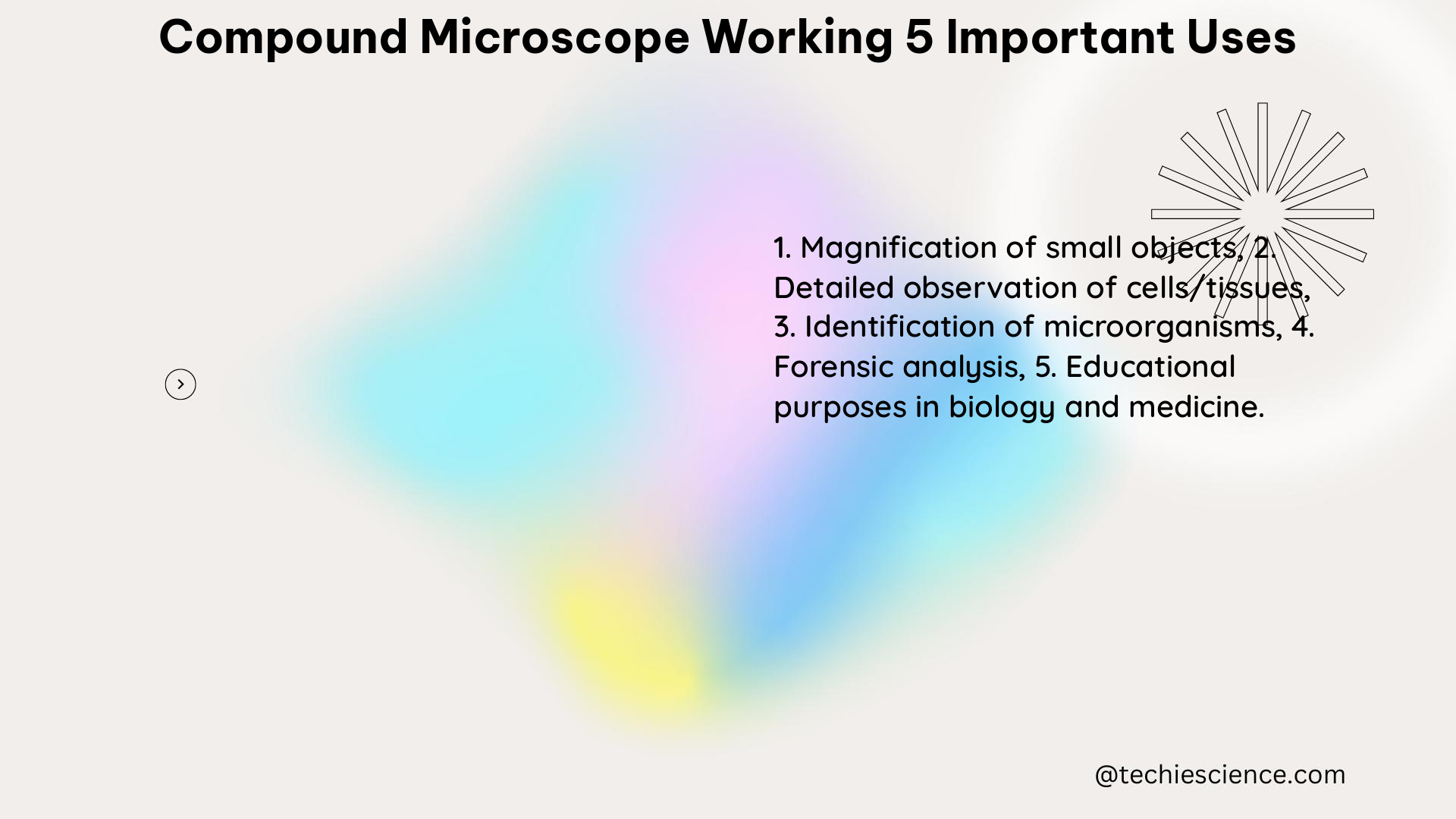The compound microscope is a powerful tool that has revolutionized the way we study the microscopic world. With its ability to magnify specimens up to 1000x, this instrument has become an indispensable tool in various fields, including medicine, biology, and materials science. In this comprehensive guide, we will delve into the intricate workings of the compound microscope and explore its five most important uses.
Understanding the Compound Microscope
The compound microscope is a type of optical microscope that uses two sets of lenses to provide a high-resolution, two-dimensional image of a specimen. The term “compound” refers to the use of multiple lenses, which is in contrast to a simple microscope that uses a single lens.
The main components of a compound microscope include:
- Objective Lenses: The compound microscope typically has 3-5 objective lenses, ranging from 4x to 100x magnification. These lenses are responsible for the initial magnification of the specimen.
- Eyepiece (Ocular) Lens: The eyepiece lens, usually 10x, further magnifies the image created by the objective lens, resulting in a total magnification range of 40x to 1000x.
- Mechanical Stage: This stage allows for precise movement of the specimen, enabling the user to focus on specific areas of interest.
- Illumination System: The compound microscope uses a light source, such as a LED or halogen lamp, to illuminate the specimen.
- Condenser Lens: The condenser lens focuses the light onto the specimen, improving contrast and resolution.
5 Important Uses of the Compound Microscope

1. Cellular and Tissue Analysis
The compound microscope is essential for studying the structural and functional details of cells, tissues, and organs. By using various staining techniques, such as hematoxylin and eosin (H&E) staining, researchers can visualize the intricate components of cells, including the nucleus, cytoplasm, and organelles. This information is crucial for understanding the mechanisms of cellular processes, disease pathologies, and developmental biology.
2. Microbiology and Pathology
In the field of microbiology, the compound microscope is used to identify and study microorganisms, such as bacteria, viruses, and fungi. This is particularly important in the diagnosis and treatment of infectious diseases. In pathology laboratories, the compound microscope is used to analyze tissue samples and detect the presence of abnormal cells or structures, which can aid in the diagnosis of various medical conditions.
3. Materials Science and Engineering
The compound microscope is a valuable tool in materials science and engineering, where it is used to analyze the microstructure and composition of materials. This includes the study of metals, ceramics, polymers, and composites. By observing the arrangement and distribution of atoms, grains, and defects within these materials, researchers can better understand their physical, chemical, and mechanical properties, which is crucial for the development of new and improved materials.
4. Forensic Analysis
In the field of forensics, the compound microscope is used to examine and compare small evidence samples, such as fibers, hair, and paint chips. By analyzing the microscopic features of these samples, forensic scientists can establish connections between evidence and suspects, which can be crucial in criminal investigations.
5. Educational Applications
The compound microscope is an essential tool in science education, particularly in biology and chemistry classes. Students can use the microscope to observe and study a wide range of specimens, from plant and animal cells to crystals and other microscopic structures. This hands-on experience helps students develop their observational skills, critical thinking, and understanding of the microscopic world.
Enhancing Compound Microscope Performance
To optimize the performance of a compound microscope, several techniques and accessories can be employed:
- Immersion Oil: When using high-magnification objective lenses (100x or higher), immersion oil is used to increase the numerical aperture and improve the resolution of the specimen image.
- Staining Techniques: Applying various stains, such as fluorescent dyes or histological stains, can enhance the contrast and visibility of specific cellular structures or components.
- Mechanical Stage: The mechanical stage allows for precise and controlled movement of the specimen, making it easier to locate and observe specific areas of interest.
- Bright-Field Illumination: The compound microscope’s bright-field illumination system provides a well-lit view of the specimen, making it easier to observe and analyze.
- Digital Imaging: Coupling the compound microscope with a digital camera or imaging system can enable the capture, storage, and analysis of high-quality images and videos of the specimen.
Conclusion
The compound microscope is a remarkable instrument that has revolutionized our understanding of the microscopic world. By mastering its intricate workings and leveraging its diverse applications, researchers, scientists, and students can unlock a wealth of knowledge and insights that are crucial for advancing various fields of study. This comprehensive guide has provided a detailed overview of the compound microscope, its key components, and its five most important uses, equipping you with the knowledge to effectively utilize this powerful tool in your scientific endeavors.
References:
- Olympus Life Science. (n.d.). Microscope Primer: Anatomy of the Microscope Stage. Retrieved from https://www.olympus-lifescience.com/en/microscope-resource/primer/anatomy/stage/
- Microscope.com. (n.d.). Five Things You Should Know About Compound Microscopes. Retrieved from https://www.microscope.com/education-center/five-things-you-should-know/about-compound-microscopes
- BYJU’S. (n.d.). Compound Microscope. Retrieved from https://byjus.com/physics/compound-microscope/
- Zeiss Campus. (n.d.). Digital Imaging: Photon Starved Imaging. Retrieved from https://zeiss-campus.magnet.fsu.edu/articles/basics/digitalimaging.html

Hi, I am Sanchari Chakraborty. I have done Master’s in Electronics.
I always like to explore new inventions in the field of Electronics.
I am an eager learner, currently invested in the field of Applied Optics and Photonics. I am also an active member of SPIE (International society for optics and photonics) and OSI(Optical Society of India). My articles are aimed at bringing quality science research topics to light in a simple yet informative way. Science has been evolving since time immemorial. So, I try my bit to tap into the evolution and present it to the readers.
Let’s connect through